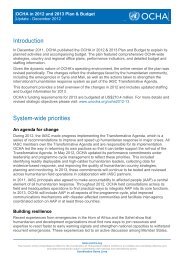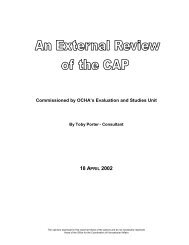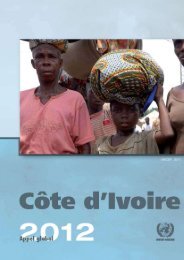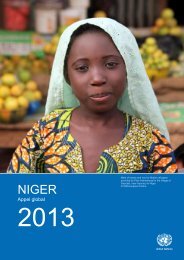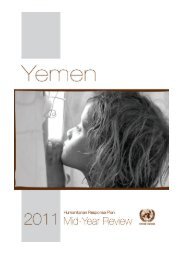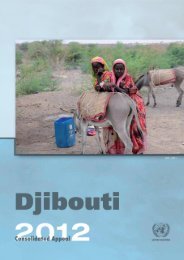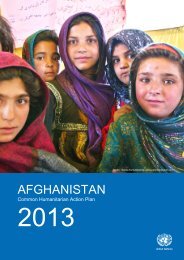Table of contents
Untitled
Untitled
You also want an ePaper? Increase the reach of your titles
YUMPU automatically turns print PDFs into web optimized ePapers that Google loves.
20[1] 2012 in review | needs analysisUnited Nations and PartnersSUDAN WORK PLAN 2012characterized by relatively low health indicators, poor infrastructureand severe limitations in human and financial resources.Access to, and coverage <strong>of</strong>, basic health care is poor in Sudan.The density <strong>of</strong> health care falls within the critical shortage zoneat 1.2 medical staff per 1,000 people, with areas affected byconflict and seasonal emergencies having fewer medical staffaccording to the World Health Organization (WHO). Limitedcapacity among health care providers also represents a seriousshortfall in the sector, including limited attention to improvinginfant and young child feeding practices.The low levels <strong>of</strong> maternal and child health care provisionremains alarming in many areas <strong>of</strong> Sudan, particularly in Darfur,South Kord<strong>of</strong>an and Blue Nile. According to the Health Sector,24.1% <strong>of</strong> women giving birth did not have access to medicalconsultation. Only 46.5% <strong>of</strong> women give birth attended by askilled birth attendant. Meanwhile, according to the WHO,the under-five mortality rate is 79 per 1,000 live births. Thepercentage <strong>of</strong> children fully immunized between the ages <strong>of</strong>12-23 months in Sudan is 49.4%.Several disease outbreaks were reported during the first half<strong>of</strong> 2012, including outbreaks <strong>of</strong> diphtheria and meningitis inDarfur. While humanitarian actors were able to respond tocontain the outbreak, and vaccination coverage remains relativelyhigh throughout Sudan, improved disease prevention,surveillance and response is required to safeguard publichealth.Humanitarian organizations play a vital role ensuring peoplein need have access to primary health care (PHC) in Darfur.Approximately 50% <strong>of</strong> health staff in Darfur is provided byhumanitarian organizations. However, the pull out <strong>of</strong> severalhealth INGOs in Darfur over the last two years has createdsignificant gaps in access to health services. For example, in2012, two INGOs pulled out <strong>of</strong> West Darfur and transferred 33health facilities to the Government, placing further strain onthe already over-stretched public health services. Building thecapacity <strong>of</strong> national health actors is critical but <strong>of</strong>ten hamperedby difficulties in maintaining a supply-chain <strong>of</strong> drugs and otheressential medical supplies.Water and SanitationAccess to safe water continues to pose a significant challengein conflict-affected areas due to low investment in waterinfrastructure, inadequate maintenance, population increasesleading to unsustainable water usage practices and depletions<strong>of</strong> acquifers as well as insecurity. During 2012, a shortage <strong>of</strong>water supply has been observed in some major IDP camps asthe camps have grown beyond the initial design and the waternetworks are no longer able to meet the current need.Critical water, sanitation and hygiene (WASH) service gapshave been reported in many returnee areas and rural communitiesin Darfur due to low rainfall last year. The prolongeddrought in parts <strong>of</strong> Darfur has led to a drastic decline in waterlevels <strong>of</strong> many water sources. To compensate, many camps arerelying on increased use <strong>of</strong> motorized water sources that are<strong>of</strong>ten susceptible to technical problems. Critical WASH gapshave also been reported in places <strong>of</strong> new displacement inSouth Kord<strong>of</strong>an and Blue Nile.Access to sanitation and hygiene also remains a seriousconcern. Access to basic sanitation in rural areas has notincreased during 2012 primarily due to weak funding andinsecurity affecting access. Poor hygiene practices due to lack<strong>of</strong> awareness persist, including open defecation, improperuse and maintenance <strong>of</strong> latrines, lack <strong>of</strong> hand washing andinappropriate water collection and storage. This underlinesa continued urgent need for hygiene-promotion awareness,particularly in light <strong>of</strong> the high prevalence and risk <strong>of</strong> hygienerelateddiseases.Protection, Displacement and ReturnsMany vulnerable people in Sudan continue to require protectionassistance. Continued fighting and displacement duringthe first half <strong>of</strong> 2012 has continued to place women, girls, boysand men directly at risk <strong>of</strong> becoming victims <strong>of</strong> the conflict.Security continues to be an issue, not just from the conflict, butalso as a result <strong>of</strong> banditry, inter-tribal fighting and criminality.The need to increase protection activities for people <strong>of</strong> SouthSudanese origin currently in Sudan has significantly increased.For those wishing to stay in Sudan, there are protection relatedconcerns, as well as their rights to secure their residency, citizenshipand access to basic services. There is, however, expectationthat Governments <strong>of</strong> Sudan and South Sudan will sign anagreement <strong>of</strong> the four freedoms. For those wanting to returnto South Sudan, there are concerns over their ability to returnin safety and dignity. Further, there has been minimal publicdissemination <strong>of</strong> information related to upcoming deadlinesand registration procedures by local authorities. Many people<strong>of</strong> South Sudanse origin are equally not aware <strong>of</strong> the stepsrequired to acquire the necessary documentation for them tostay or return.Due to the limited options for return and the increasinglyexposed environment for the South Sudanese population,there is a continuing need to advocate for both governmentsto ensure the protection and welfare <strong>of</strong> people <strong>of</strong> South Sudaneseorigin in Sudan and Sudanese in South Sudan, and toopen safe corridors for those wishing to return to be able todo so.In Darfur, returnees have <strong>of</strong>ten faced significant challenges,including a lack <strong>of</strong> basic services in return areas, disagreementsover land ownership in some cases and lack <strong>of</strong> rule <strong>of</strong> lawinstitutions, such as the presence <strong>of</strong> police. The lack <strong>of</strong> basicservices provided by the Government <strong>of</strong> Sudan remains one <strong>of</strong>the key areas to be addressed to promote durable solutions.There is therefore a need to work with the Government andother sectors to ensure that those returning are provided withadequate levels <strong>of</strong> assistance and reintegration as required inorder for returns to be sustainable. Continuing support andmonitoring <strong>of</strong> the refugee population in eastern Sudan isrequired given further asylum seekers/refugee arrivals.




